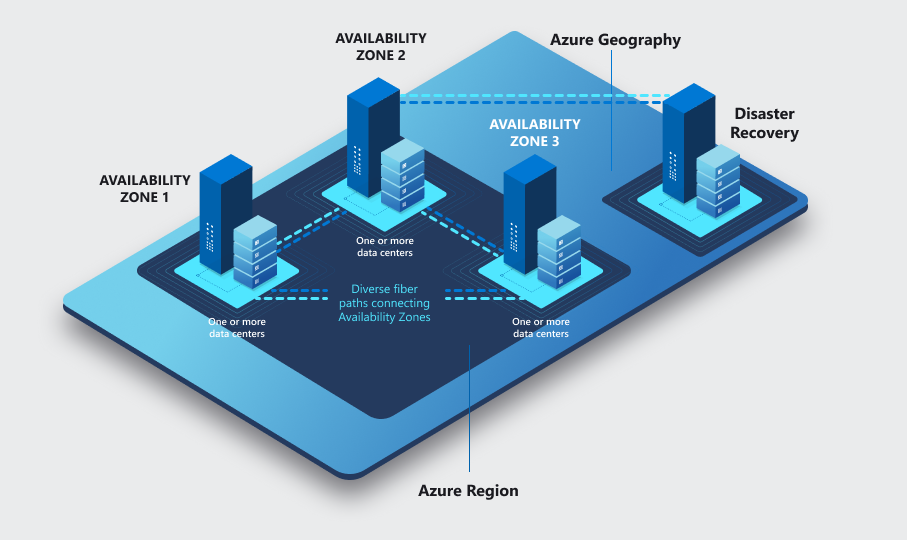Azure cross-region replication
Many Azure regions provide availability zones, which are separated groups of datacenters. Within a region, availability zones are close enough to have low-latency connections to other availability zones, but they're far enough apart to reduce the likelihood that more than one will be affected by local outages or weather. Availability zones have independent power, cooling, and networking infrastructure. They're designed so that if one zone experiences an outage, then regional services, capacity, and high availability are supported by the remaining zones.
While Azure regions are designed to offer protection against local disasters with availability zones, they can also provide protection from regional or large geography disasters with disaster recovery by making use of another secondary region that uses cross-region replication. Both the primary and secondary regions together form a region pair.
Cross-region replication
To ensure customers are supported across China, Azure maintains multiple geographies. These discrete demarcations define a disaster recovery and data residency boundary across one or multiple Azure regions.
Cross-region replication is one of several important pillars in the Azure business continuity and disaster recovery strategy. Cross-region replication builds on the synchronous replication of your applications and data that exists by using availability zones within your primary Azure region for high availability. Cross-region replication asynchronously replicates the same applications and data across other Azure regions for disaster recovery protection.

Some Azure services take advantage of cross-region replication to ensure business continuity and protect against data loss. Azure provides several storage solutions that make use of cross-region replication to ensure data availability. For example, Azure geo-redundant storage (GRS) replicates data to a secondary region automatically. This approach ensures that data is durable even if the primary region isn't recoverable.
Not all Azure services automatically replicate data or automatically fall back from a failed region to cross-replicate to another enabled region. In these scenarios, recovery and replication must be configured by the customer. These examples are illustrations of the shared responsibility model. It's a fundamental pillar in your disaster recovery strategy. For more information about the shared responsibility model and to learn about business continuity and disaster recovery in Azure, see Business continuity management in Azure.
Shared responsibility becomes the crux of your strategic decision-making when it comes to disaster recovery. Azure doesn't require you to use cross-region replication, and you can use services to build resiliency without cross-replicating to another enabled region. But we strongly recommend that you configure your essential services across regions to benefit from isolation and improve availability.
For applications that support multiple active regions, we recommend that you use available multiple enabled regions. This practice ensures optimal availability for applications and minimized recovery time if an event affects availability. Whenever possible, design your application for maximum resiliency and ease of disaster recovery.
Benefits of cross-region replication
The architecture for service cross-regional replication and data can be decided on a per-service basis. You'll need to take a cost-benefit analysis approach based on your organization's strategic and business requirements. Primary and ripple benefits of cross-region replication are complex, extensive, and deserve elaboration. These benefits include:
- Region recovery sequence: If a geography-wide outage occurs, recovery of one region is prioritized out of every enabled set of regions. Applications that are deployed across enabled region sets are guaranteed to have one of the regions prioritized for recovery. If an application is deployed across regions, any of which isn't enabled for cross-regional replication, recovery can be delayed.
- Sequential updating: Planned Azure system updates for your enabled regions are staggered chronologically to minimize downtime, impact of bugs, and any logical failures in the rare event of a faulty update.
- Physical isolation: Azure strives to ensure a minimum distance of 300 miles (483 kilometers) between datacenters in enabled regions, although it isn't possible across all geographies. Datacenter separation reduces the likelihood that natural disaster, civil unrest, power outages, or physical network outages can affect multiple regions. Isolation is subject to the constraints within a geography, such as geography size, power or network infrastructure availability, and regulations.
- Data residency: Regions reside within the same geography as their enabled set to meet data residency requirements for tax and law enforcement jurisdiction purposes.
Although it's not possible to create your own regional pairings, you can nevertheless create your own disaster recovery solution by building your services in any number of regions and then using Azure services to pair them. For example, you can use Azure services such as AzCopy to schedule data backups to an Azure Storage account in a different region. Using Azure DNS and Azure Traffic Manager, you can design a resilient architecture for your applications that will survive the loss of the primary region.
Azure controls planned maintenance and recovery prioritization for regional pairs. Some Azure services rely upon regional pairs by default, such as Azure redundant storage.
You aren't limited to using services within your regional pairs. Although an Azure service can rely upon a specific regional pair, you can host your other services in any region that satisfies your business needs. For example, an Azure GRS storage solution can pair data in Canada Central with a peer in Canada East while using Azure Compute resources located in China East.
Azure paired regions
Many regions also have a paired region to support cross-region replication based on proximity and other factors.
Important
To learn more about your region's architecture and available pairings, please contact your Azure sales or customer representative.
Azure operated by 21Vianet regional pairs
| Geography | Regional pair A | Regional pair B |
|---|---|---|
| China | China North | China East |
| China North 2 | China East 2 | |
| China North 3 | China East 3* |
(*) Certain regions are access restricted to support specific customer scenarios, such as in-country/region disaster recovery. These regions are available only upon request by creating a new support request.